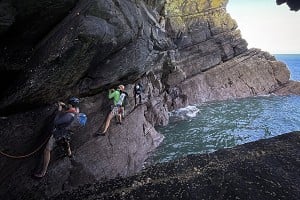
Pete Edwards shares advice for dog owners who want to take their canine companions to the crag...
I used to have a theory in the first few years of my climbing career: if you want to climb hard, get a dog. Look back on those climbing videos of old and check out how many of them featured a crag dog and there are loads: Hard Grit, Stick It - the Nesscliffe guide even has a collie on the cover!
It's a bit of silliness, granted, but dogs and climbing have often gone hand in hand. A quick search on Instagram found that #cragdog had more than 36,000 posts. After all, taking your pooch with you on your jaunts to the outdoors makes a lot of sense, if you've done it the right way.
What about when you've just got your dog? Those first forays into the hills with your new canine companion can be a bit daunting and there are plenty of worries about what might be. This isn't just taking the dog for a walk, you'll want to be climbing and not focusing your attention on the pooch. Will they be OK with that?
Tess, my resident border collie, arrived in my life in November 2014. She was a rescue dog from a local centre, still in puppydom and utterly neurotic. As someone who had never owned a pet before, just getting used to life together was a bit of a challenge at first, but now she is probably the best crag dog I could hope for. Often, she's the inspiration to head outside to the crag rather than just go to the gym, meaning sometimes it's her that drags me out climbing and not the other way around.
This has not happened overnight and it's testament to her more than anything that she has been able to adapt and learn about what is acceptable, what is expected and what she gets in return. There have been a few issues along the way – including an extended trip for a week in Northern France after a mix-up with her rabies jab – and some raging successes, so here are some of the highlights, hints and tips for taking your canine to the crag.
CRUCIAL POINT TO BEGIN: your dog's behaviour is your responsibility. Blaming their breed or their temperament will not help you: it is you that has taken them with you. Respect other people – they have just as much right to be there as you or your pooch – and more importantly, respect the landowners; you could be endangering their livelihood and access for others. If a problem develops, stick your dog back on the lead and if you need to, take them home. It is down to the owner to ensure the dog is well behaved.
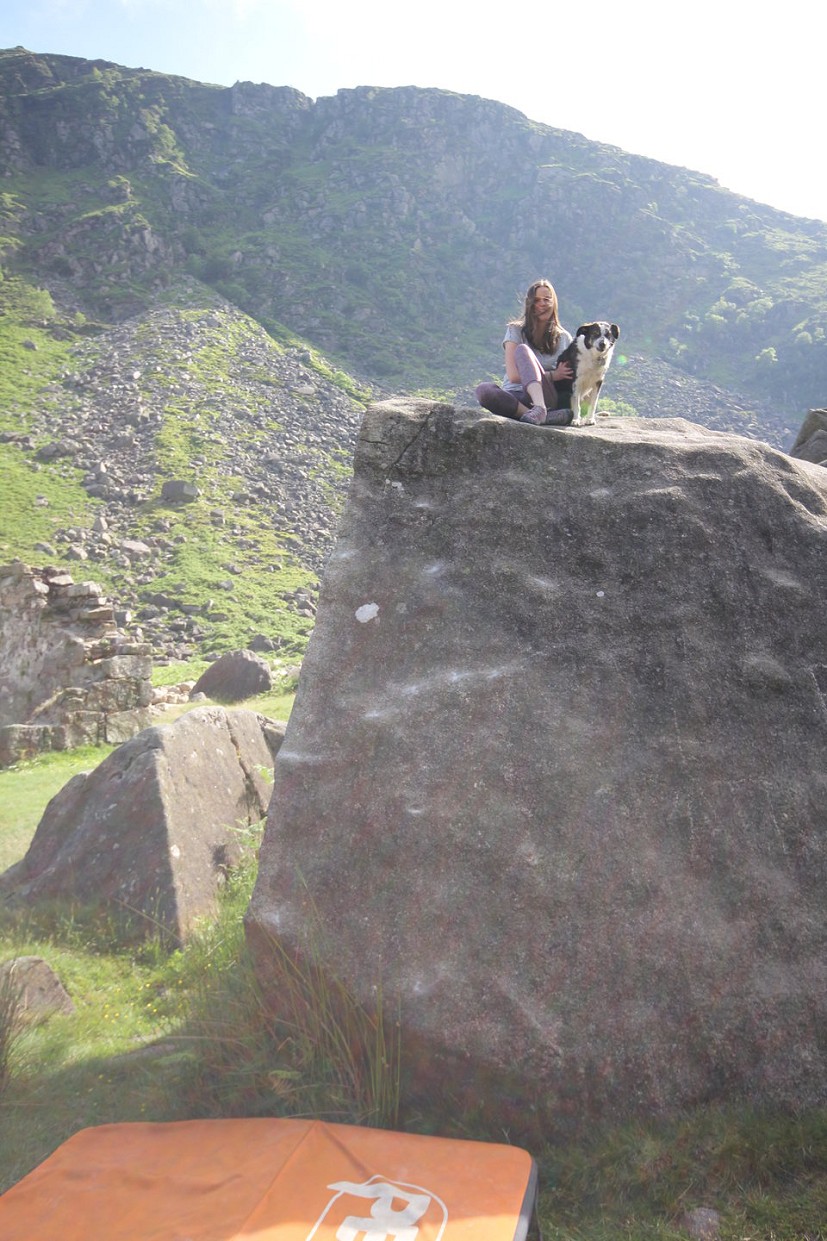
Remember: Not everyone likes dogs
When I asked for suggestions on a local Facebook group, one of the overwhelming points was from non-dog owners. One comment read: "I think some dog owners find it hard to grasp that not everyone adores dogs, and some people are in fact terrified of them." This is really important to remember. For those of us with dogs, they are our faithful friends that we want to spend time with, hence taking them out, but not everyone feels the same and there are plenty of people out there who suffer with Cynophobia. Those people have just as much right as we do to be there, so be conscious of this.
One commentator said: "I have a climbing friend who is terrified of dogs. One time a dog went over and licked her hands as she was belaying me. I'm so proud she managed to keep her shit together!" This is the responsibility of the dog owner to be sure this doesn't happen.
Emily Pitts made things very clear, stating: "Keep your dog away from other people's lunch; Don't allow your dog to sniff around other people's bags and belongings; Keep your dog under control so they aren't wandering around and tripping belayers up." While some of this may stem from one particular bad experience, remember that you and your dog are representative of a wider group – in exactly the same way as climbers are a group of outdoor enthusiasts – and we all need to set a good example.
In the end, if your dog is causing a problem, it's you that needs to leave, not those who are offended.
Introduce Your Dog to Other Climbers
All that being said, in my experience, people generally love a good crag dog, assuming they're well behaved and good natured. Tess makes more friends meeting people at a crag than I do and I've yet to find many people who don't like her being around.
When you first arrive, check out who's around and have a conversation. An introduction to both you as the owner and the dog can go a long way to creating a good environment and avoiding conflict. Whether people are scared, bothered or fine, at least then you know where you stand.
Try and Keep Them in Sight
Not just so you can keep tabs on them, this is as much for their benefit. Dogs often don't like to lose sight of you, they can think you've abandoned them but if they can see you, it eases their worry slightly. Okay, I'm no dog psychologist but that's how it seems at least.
Whether it's a trad climb or a boulder, if they can see you, they're much happier, so bear this in mind if you're tethering them up before you start.
Obey Standard Rules for People
This sounds like an odd point but think of it this way: you wouldn't want another person rooting through your bag and trying to eat your food/shoes/guidebook so why should the dog be any different? If your hound is predisposed to foraging, this is something you'll need to find a way of dealing with, either by training them or by tethering them somehow. Whichever way you do this, you HAVE to get it right.
Training Your Dog Before You Go Out
My personal opinion – based on having a typically farm-dog style collie – is that dogs can often become more aggressive when tied up and so training them is always my preferred option. That doesn't come easy and this next section looks at how we can strive towards that dream crag dog.
Build Trust
Taking your dog with you is far easier if you have a relationship with your dog that allows you to let them off the lead and that starts at home. The crucial aspect of this is that you know they'll return when you call them so practice this in a safe environment where the repercussions of them not returning are significantly less problematic. Walks with retractable leads are useful for this: keep them on the lead, give your dog plenty of slack and whistle or call them back. A quick tug on the lead can remind your pooch what you want them to do on that command.
Once your dog has sufficiently earned your trust, pick somewhere suitable and try it off the lead.
Teach Independence
This one was hard work. When we first started heading out, as soon as we stopped I'd be hounded by the hound, making for a battle to get on the wall long enough to try something before she started whining. These days it's not a problem and Tess will wander about by herself, coming back periodically or when called or whistled. In places like Font, she'll often make friends on her own – people who want to throw sticks for her – and I can leave her to her own devices.
This takes a lot of time and again comes down to trust.
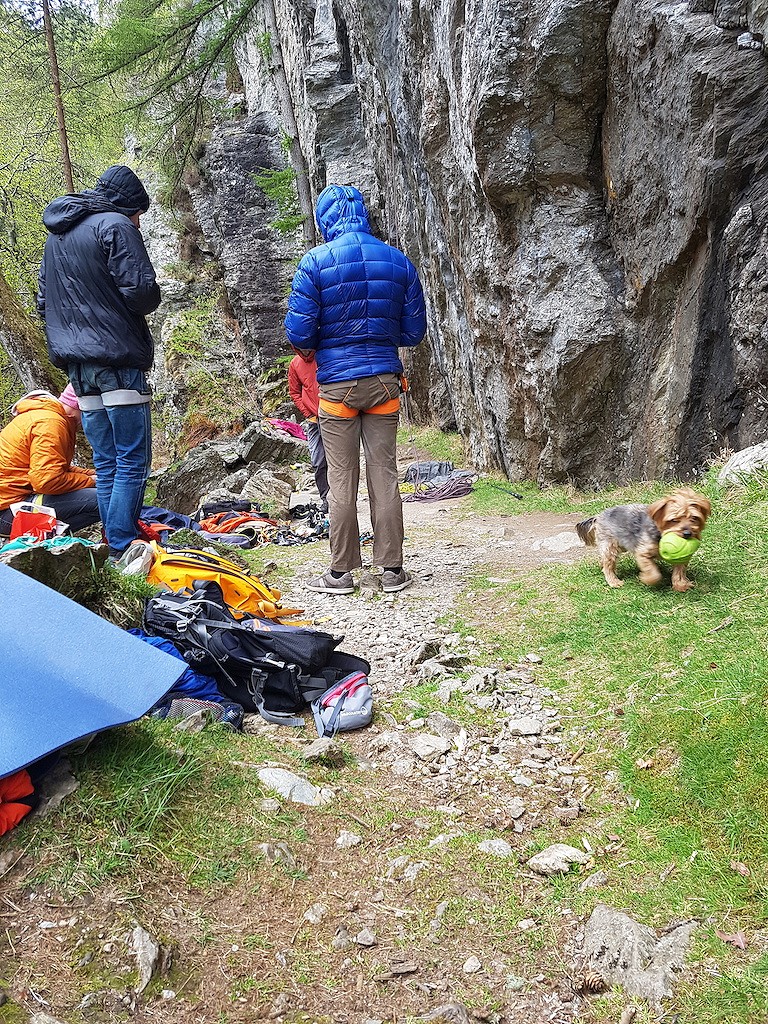
Teach Non-Verbal Cues
Likewise the hills are full of non-climbers – no, really, they are – too and people don't necessarily want to hear you bellowing across the hillside to try and control your furry friend. Whether tied up or not, you need to be able to communicate with your pet from a distance and whistle commands and visual cues can be much nicer for those around you. Again, this is best done in a safe environment where you can try it with little consequence (such as a regular quiet walk) and will take a lot of practice.
Mix up Your Dog's Routine
Tess used to come to work with me and we would regularly go climbing straight from work. Sometimes that meant not getting home until gone 10pm so if she had had a fixed meal time, we'd have had a problem.
I've always made sure she doesn't get into too much of a routine so this isn't a problem. If we're out late, she'll get fed as soon as we get home but because we've always done this, she knows it and doesn't mind. She'd rather be out and eat late than miss out on coming with me.
Another option would be to take a snack with you to keep the appetite suppressed until you can get home for their usual evening feed. I've even been known to stash food at work on days when I know I'm going to be out super late.
Keep Them off The Pads
In terms of bouldering, I was a little concerned I'd take a fall off a problem only to find my dog curled up all comfy on the soft foam pad underneath me and that wouldn't end well for either of us. So I trained her not to go onto the pads at all. Even now, if I'm lying there in a heap, she will come over to check on me but won't step on the pad without a lot of encouragement. Indy Climbing Wall owner Jon Ratcliffe agrees that keeping dogs off your pads is "important to train" into them.
It's worked a treat and is easy to do, if you're consistent and teach them well. One option would be to take a blanket for them that is theirs so if you place that on the pad, they're all good. If not, kick them off. Your dog will learn this, they're clever beasts and it will be in everyone's best interests in the long run.
Dan Lane suggests an alternative: "Start off taking a dog towel or something to the crag to settle them when you leave them, then make that something smaller, like a jacket, then smaller, and after a while, they'll be happy enough just sat with your rucksack"
The idea of heading out to the hills and then staying still for a prolonged period may be a bit unusual for your dog to begin with and settling them into the idea is important; just as it was when they first moved in with you.
Your Climbing Kit is Not a Toy
While you may be able to distinguish between your climbing rope and a bit of tat, the same may not be true of your canine companion. The same goes for your rack, your harness, your shoes and teeth marks on any piece of fabric I climb with would mean instant retirement for me. Worse still would be if my dog decided to have a nibble on someone else's kit, meaning I'm now having to replace their stuff, not to mention curtailing their day and potentially causing one unholy row.
One reply on the thread read: "We made chew toys out of old climbing rope when ours was a pup. In hindsight this was a daft idea." He doesn't elaborate as to why but I'm sure we can guess. Leave rope for climbing and something else for toys.
Get Tick and Flea Treatment
Not necessarily something to take with you, more something to take orally… Very important in many areas and don't expect them to keep your dog totally tick-free; they'll still get some. Believe me though, without any treatment, they'd have an awful lot more.
Some extra Bits to Take
We all come with accessories these days and your dog is no different. The good news is that you don't actually need that much and you can even get some Ruffwear panniers for the pooch if you're so inclined. I've never found it much of a problem carrying a few more bits, though.
Get a Harness
This was one of the first things I bought for Tess and while I don't use it often these days, I do often curse myself that I haven't got it. Lifting a dog over a fence or a gate isn't a problem with a terrier but anything bigger than a "small dog" and it becomes tricky. It gets even tougher when you've got to lift them into the road and try and keep hold of the lead at the same time. Something like a Ruffwear Webmaster harness makes this much easier.
If you do need to walk them on the lead for a section, say a road walk, a harness can also be much more comfortable for your dog, rather than having something pulling at the neck.
And a Long Lead
A long length of climber's cord is invaluable; something like 10m of 6mm accessory cord. It gives you a long tether to keep them in place while you're on your sport route or can allow you to try that roadside project without fear of them suddenly running into the road.
It can also be useful for training your pooch if you come across a field of sheep, for example. Rather than a standard lead, a long length can give your dog a limited level of freedom to build trust between you and allow you to teach your dog what is acceptable while not risking them becoming out of your control.
And Maybe a Toy
It is useful to give your pooch something to occupy themselves with. If you've got mates along, it's perfectly possible they'll spend a lot of their time throwing the toy for the dog anyway or playing – this happens an awful lot in my experience.
One thing to be cautious of is that you don't take a toy that has cost you much money. I try and avoid any toy that's cost me any money these days! While I'm not an advocate of leaving anything behind, it is quite common for the little furry creature to lose whatever you've taken down a crevice in a boulder field, never to be seen again. I've been known to go back the following day to try and find it, to no avail.
Remember a Bowl
I remember getting a very disgusted look from a friend when I was forced to open my water bottle and let my dog drink from the top of it. While I had plenty of water, I didn't have anything for her to drink it from and on a hot day, she was parched. I had no choice and it came down to the fact I hadn't brought a bowl for her to drink from. (I did clean the water bottle before I used it again though.)
Most of the time in the UK, especially in North Wales, there is a nearby stream or puddle that is ample for her but when there's not, I need to make sure I've got a way of getting her a drink. These days, there's some poo bags in my climbing bag and if the worst comes to the worst, I can dig a hole in the ground with my heel and stick a clean bag in it with some water in. As Dan Lane commented, when he takes his dog Alfie out with him, "folding fabric water bowls, rather than a big metal/plastic thing" are much better.
Some Logistical Considerations
As with any change to your routine, taking your dog climbing with you changes a few things and it's worth considering these before you're about to head out the door.
Deal with the Poo (Somehow)
This seemed like an obvious paragraph to write at first, but on reflection is a little more complex. First of all the obvious bit: if your dog does their business somewhere inappropriate, you need to deal with it. The 'how' is the more complex bit.
One habit of some dog owners of late is to bag up the poo and then leave the bag. This is not okay. We've all become very plastic conscious in recent times and leaving plastic bags around the outdoors is simply not acceptable; you'd be better leaving the poo alone.
And that leads to an interesting question: can you leave dog poo where they go? Potentially, yes you can and my collie has a wonderful habit of disappearing into the bushes and going where no-one else will tread. For me, that's ideal as there is no need for me to trudge through undergrowth to fish out poo that will quickly degrade – or be food for the bugs – and nobody will notice anyway. Although if she goes on the path, this isn't okay either.
That doesn't necessarily mean having to bag it and take it home though. Some places have signage for dog owners to "stick it and flick it" whereby they flick the poo with a stick into the undergrowth. Again, it can be good for the microclimate and many crags are on farmland, with roaming livestock. If you start picking up all the poo you can find, you'll never leave.
The important thing for the owner is judgement. My dog has done something here, is anyone going to see it? Do I need to move it? Is there anywhere suitable to put it? Then I should bag it and take it home. And of course, if they're about to go right by someone else's belongings, deal with it before they start. Again, be courteous to other, non-dog-lovers that are around.
Crags: Convenient Isn't Convenient Any More
Remember when you used to love a quick session at that roadside crag? Like the Cromlech boulders or Parisella's Cave? Yeah, well, where that used to be ideal now it's a pain. Unless of course you want to tether your dog for the duration of your session, but then with no walk in and no ability for them to run and sniff, there seems little point taking them.
Instead, leave those venues for your dog-free days and pick somewhere a bit more off the beaten track. That doesn't mean you need to be heading into the middle of nowhere a half-hour from the car, just that even if your dog is normally on the lead, you need to think what will happen if they suddenly escape. Plus the exercise on the way there and back will keep them a bit less manic.
Watch Out For Livestock
While crags are often on CROW land and you may have access, farmers can get very nervous when they see animals around their livestock and rightly so; it is their livelihood and a spooked sheep around lambing season, for example, can have terrible consequences.
The penalty for worrying livestock could set you back with a fine of £1,000 or at worst, you may find a farmer rightly or wrongly shooting your dog. Whatever your opinions on these actions, they are very real and require thought before you set out.
If you've got a very good relationship with your dog, it is possible to train them to stay close when there are other animals around, but if you're in any doubt, keep them tethered. It is really not worth jeopardising access or upsetting local farmers, not to mention getting yourselves in trouble. There are humane ways to train your dog to this effect, for any breed – my border collie will now come straight back to me as soon as she sniffs a sheep – and remember as the dog owner, it is your responsibility to make sure nothing goes wrong.
Enjoy that they're With You!
If it becomes a chore to take your dog, in that they won't leave you alone and you're not getting any climbing in, then you need to question how well it's working. Persevere, as it doesn't always come easy, but remember why you're doing this. If you're having a break, engage with the dog! Play with them, give them some fuss and remember that the reason you're going to all this trouble is to spend some time with them.
If they're happy, you're more likely to be happy and no dog wants to be dragged out to a crag only to be ignored. So when the time is right, make sure you're interacting with your pooch. And enjoy yourselves.
A huge thanks for helping with this article goes to Ruffwear UK for their support in our adventures and to all those who offered comment on the thread in the North Wales Climbers group on Facebook. Finally, the biggest thanks goes to my dog Tess, who has become my constant canine crag companion and has been possibly the best non-climbing bouldering companion I have ever had.
- DESTINATION GUIDE: Helsinki Bouldering 3 Sep, 2019
- ARTICLE: Bouldering with Babies 18 Jul, 2019
- DESTINATION GUIDE: Swedish Bouldering 8 Jun, 2017
- Neil Gresham and a Preposterous Tale at Creation Walls 17 Feb, 2006
- Why do we climb? 5 Dec, 2005

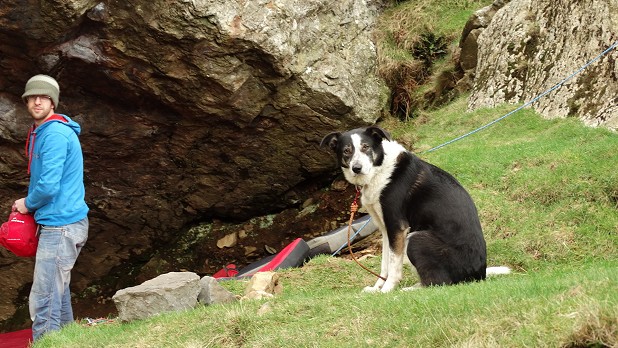

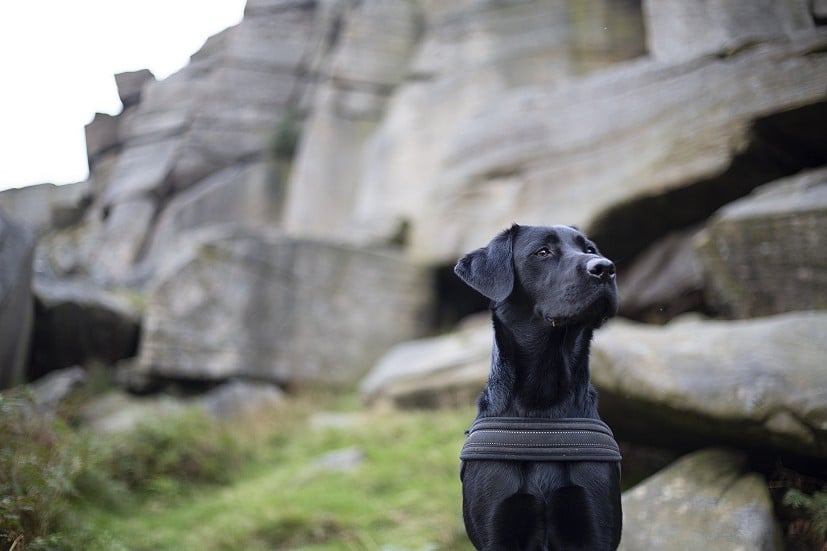
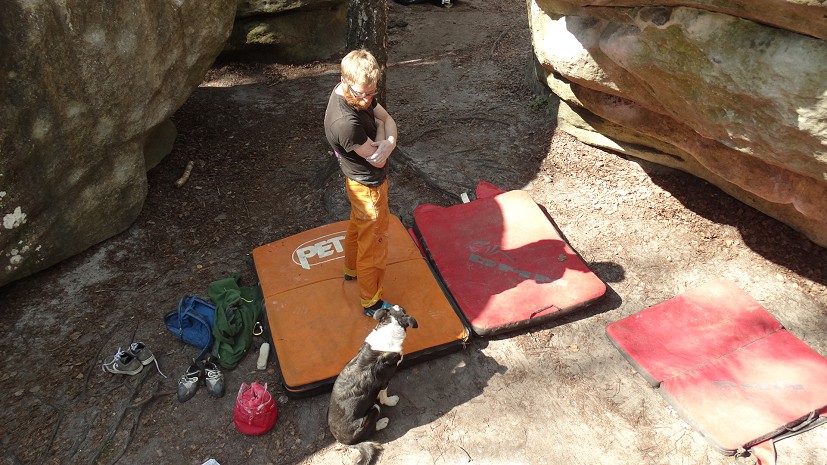
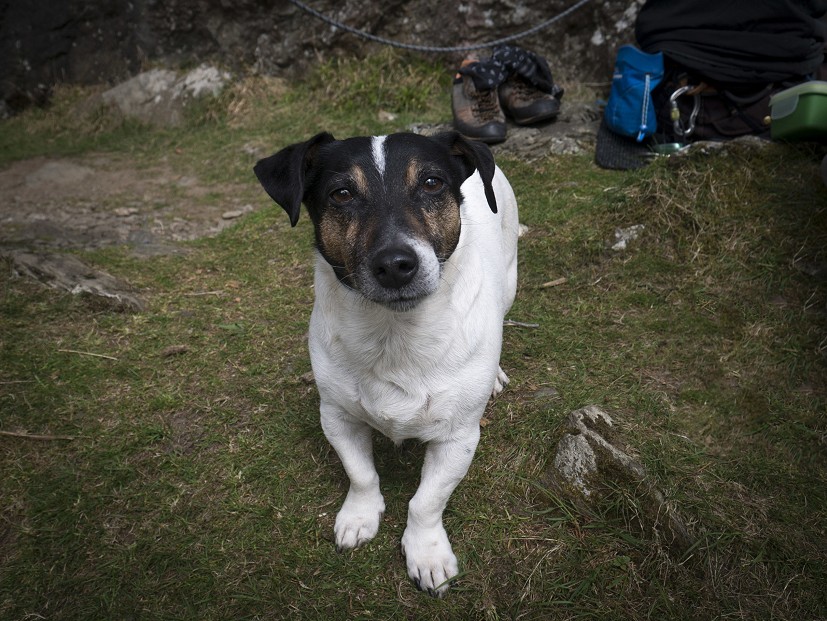


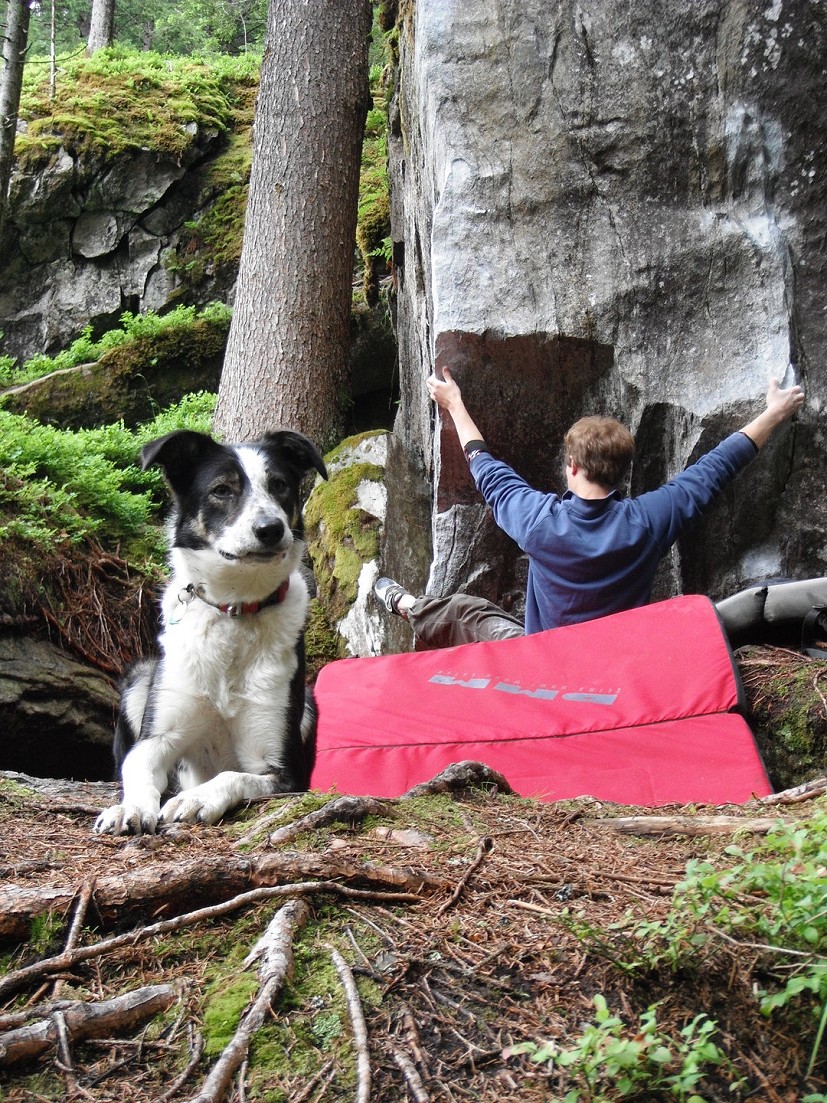


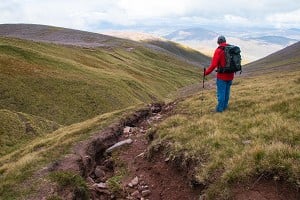
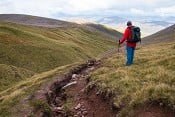
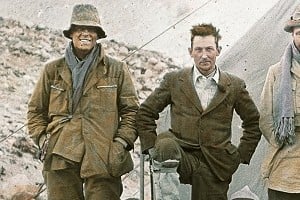
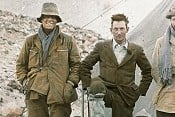








Comments
Love the picture of Hester keeping warm - excellent!
One thing I have learned from UKC which has altered my behaviour is this: if there is farm livestock around it is not OK to leave dogshit wherever the dog deposits it. Pain though it is, if my little mate does one in the middle of a field of cows or sheep I bag it and bring it home. I can't remember which UKC er it was who altered my thinking but I didn't doubt his explanation for a minute.
Thanks for this, especially the request to respect people who don't like dogs. It seems that any thread about dogs on here will quickly polarise into lovers v haters, with no middle ground, so there is obviously something going wrong out there. Most people, even if they don't like dogs, will tolerate a dog without complaint if it's obviously under control and not bothering them.
To understand the perspective of non-dog lovers, imagine you go to the crag on a rare lovely day and encounter a family with a toddler. "Don't worry, he's friendly", they say. Now imagine that toddler starts poking around your rucksack, eating half of your lunch, sitting on your climbing gear, pooping next to the trail, sticking its wet nose in your crotch, licking your ankle, starting fights with other toddlers nearby, napping on your bouldering pad, chasing wildlife away, whining and shouting, and distracting you and/or your belayer/spotter while you are trying to climb. The parents are friendly, but they seem incapable of, or unwilling to, control their child, and they don't understand why you don't love their adorable child just like they do.
Now maybe you have a better sense of how non-dog lovers feel about dogs at the crag. Please consider leaving your dog at home or at least keeping them on a leash, out of the way, and quiet, and please pick up their poop. Thank you.
Same with kids? :)
Joking aside, I don't own a dog any more and just walk one occasionally but having spent years running and walking in the area I can assert there is nothing worse than an owner who claims his dog is under control when it quite obviously isn't.
In fact, my experiences have led me to believe that NO dog is under control 100% of the time unless it is on a lead. It's like watching police dogs on those awful TV programs where they delight in showing us canine crimefighters bringing down the crims. For , say, 95% of the time the handler has it doing his bidding but I suspect that in the closing few seconds before it locks on to the suspect its uniformed buddy might as well be on Mars for all the input he has in what happens. I'm sure plenty of UKC dog owners will disagree and claim that they are in total control of their pet all the time it's off lead and I really hope that events never prove them wrong.